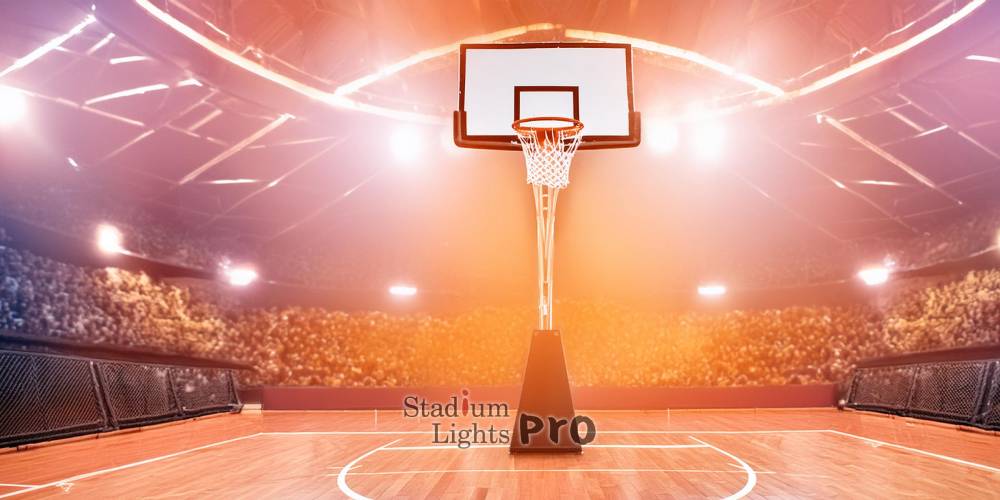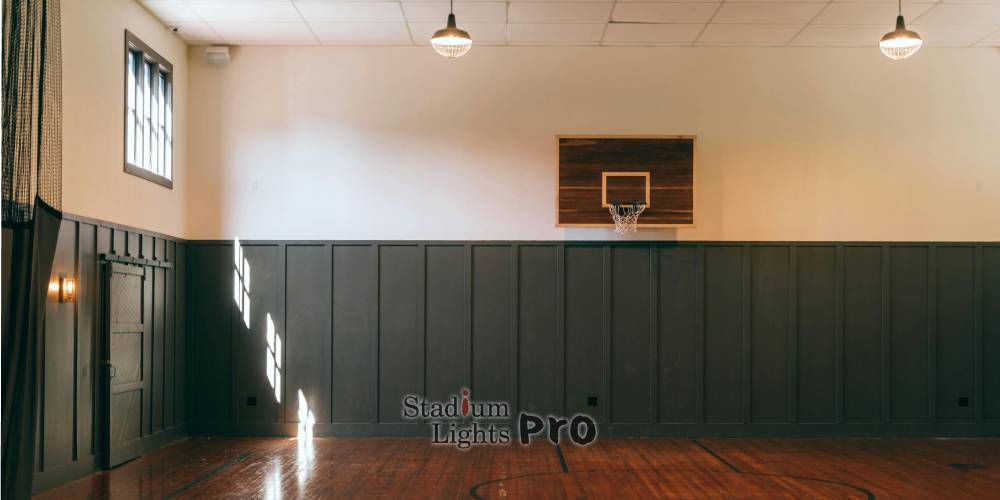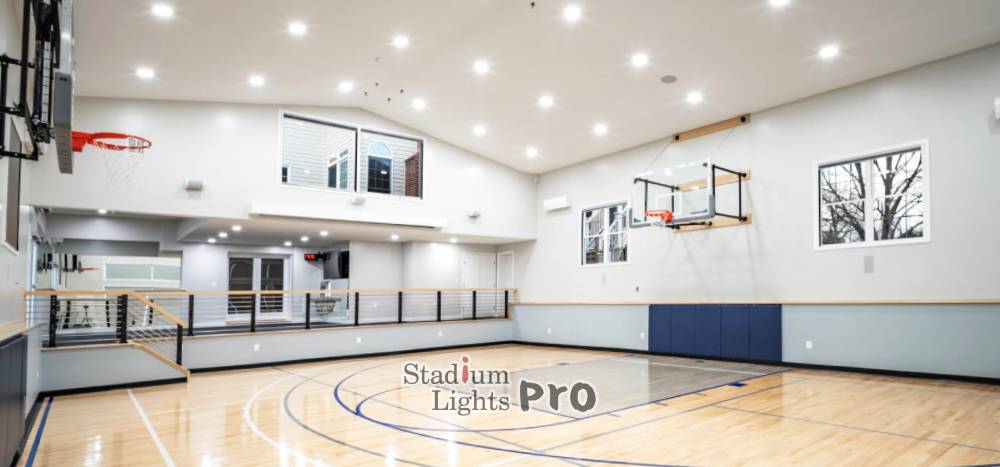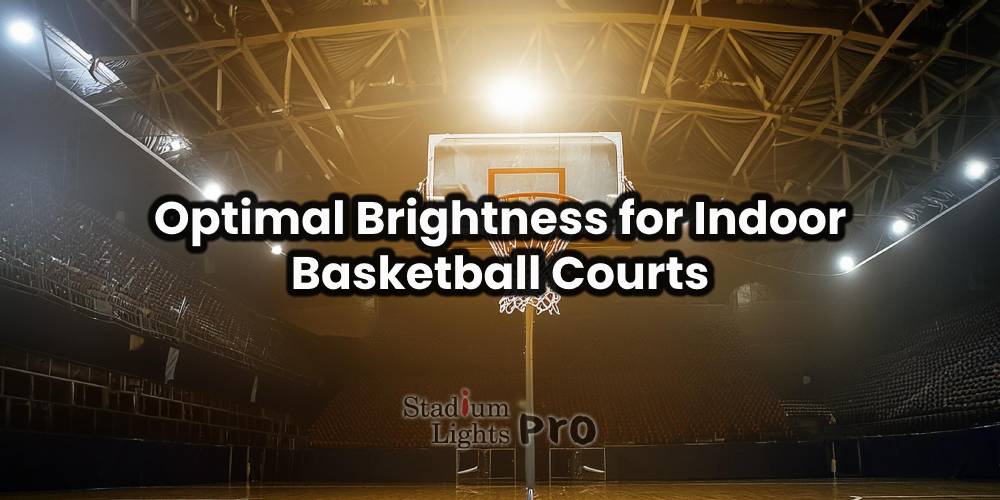The importance of optimal lighting in indoor basketball courts cannot be overstated, as it directly impacts player performance, spectator experience, and overall safety within the facility. Clear visibility is crucial for players to accurately judge distances, react swiftly, and maintain peak performance levels during gameplay. Additionally, spectators rely on well-lit environments for an enjoyable viewing experience, which can influence attendance and engagement. LED lighting technology offers a comprehensive solution to these requirements, boasting energy efficiency, longevity, and the ability to customize light levels and distribution. Its adoption represents a significant advancement in sports lighting, providing facilities with the means to achieve optimal brightness while reducing energy costs and environmental impact.

Table of Contents
ToggleFactors Influencing Optimal Brightness
Player performance
Player performance on indoor basketball courts is significantly influenced by lighting conditions. Adequate illumination is essential for players to perceive their surroundings accurately, judge distances effectively, and react swiftly to game dynamics. Optimal lighting levels can enhance visibility, enabling players to track the ball and opponents with greater precision, leading to improved passing accuracy, shooting proficiency, and overall performance. Moreover, consistent and uniform lighting across the court minimizes distractions and helps players maintain focus throughout the game. In contrast, poor lighting, such as insufficient brightness or uneven distribution, can hinder players’ ability to perform at their best, impacting their reaction time, shooting accuracy, and overall gameplay experience. Therefore, optimizing lighting conditions to meet the specific needs of basketball players is crucial for maximizing their performance potential on the court.
Impact of lighting on visibility
The impact of lighting on visibility is paramount in indoor basketball courts, directly affecting players’ ability to perceive their surroundings accurately. Adequate illumination ensures that players can track the ball’s trajectory, discern the movements of teammates and opponents, and anticipate game dynamics effectively. Clear visibility enables players to make split-second decisions with confidence, contributing to improved gameplay performance. Conversely, poor lighting conditions, such as dimness or glare, can obscure critical visual cues, leading to decreased visibility and potentially compromising player performance. Therefore, optimizing lighting to provide consistent brightness and minimize glare is essential for maintaining optimal visibility and facilitating peak performance on the basketball court.
Effects on shooting accuracy and reaction time
The effects of lighting on shooting accuracy and reaction time are significant factors in indoor basketball courts. Well-designed lighting that provides consistent brightness and minimal glare can positively impact a player’s ability to shoot accurately and react swiftly during gameplay. Adequate illumination allows players to gauge distance and depth perception more accurately, leading to improved shooting precision and higher success rates. Moreover, optimal lighting conditions contribute to faster reaction times, enabling players to anticipate movements, make quick decisions, and execute plays with greater agility and efficiency. Conversely, poor lighting, characterized by uneven brightness or excessive glare, can impair a player’s ability to judge distances accurately and react promptly, resulting in decreased shooting accuracy and slower reaction times. Therefore, optimizing lighting to enhance shooting accuracy and reaction time is essential for maximizing player performance on the basketball court.
Spectator experience
The spectator experience is a critical aspect of indoor basketball games, and lighting plays a significant role in shaping it. Clear and well-distributed illumination not only enhances the visibility of the game but also contributes to the overall atmosphere and enjoyment for spectators. Adequate lighting ensures that spectators can follow the action on the court with ease, enabling them to fully engage in the game and cheer for their favorite teams. Moreover, optimal lighting levels create a comfortable viewing environment, reducing eye strain and fatigue for spectators during extended periods of gameplay. Besides, well-designed lighting can highlight the excitement and intensity of key moments in the game, enhancing the overall drama and spectacle for those in attendance. In contrast, poor lighting quality or uneven distribution can detract from the spectator experience, leading to frustration and disengagement. Therefore, prioritizing the spectator experience when designing lighting systems for indoor basketball courts is essential for creating an immersive and enjoyable environment for fans.
Importance of clear visibility for audience enjoyment
Clear visibility is paramount for audience enjoyment in indoor basketball games, as spectators rely on being able to see the action on the court to fully engage with the game. When visibility is compromised due to poor lighting or glare, spectators may struggle to follow the movement of players, track the trajectory of the ball, or understand the dynamics of the game. This can lead to frustration, disconnection, and diminished enjoyment of the overall experience. Conversely, when lighting is optimized to provide clear visibility throughout the court, spectators can easily follow the flow of the game, anticipate exciting moments, and feel more immersed in the action. Clear visibility enhances the sense of excitement, involvement, and emotional connection for spectators, making the game more enjoyable and memorable for everyone in attendance. Therefore, prioritizing clear visibility in lighting design for indoor basketball courts is essential for ensuring a positive and engaging experience for the audience.
Potential impact on attendance and engagement
The potential impact on attendance and engagement in indoor basketball games is closely tied to the quality of lighting. Optimal lighting conditions that ensure clear visibility and enhance the overall viewing experience can have a positive effect on attendance levels. When spectators can easily follow the action on the court and feel comfortable in the viewing environment, they are more likely to attend games regularly and stay engaged throughout. Moreover, well-lit venues create a more inviting atmosphere that attracts fans and encourages them to participate actively in the game, whether through cheering, chanting, or interacting with other spectators. On the other hand, poor lighting quality or insufficient brightness may deter potential attendees, leading to lower attendance rates and reduced engagement levels among those who do attend. Therefore, investing in high-quality lighting systems that enhance visibility and create an enjoyable atmosphere can have a significant impact on boosting attendance and fostering greater engagement among basketball fans.
Safety considerations
Safety considerations are paramount in indoor basketball courts, particularly concerning lighting. Proper illumination is essential to ensure a safe playing environment for athletes and spectators alike. Insufficient lighting can obscure obstacles on the court, increasing the risk of slips, trips, and other accidents. Moreover, uneven lighting or glare can create visual distractions for players, compromising their ability to react quickly and avoid collisions. Additionally, well-designed lighting helps to minimize shadows and enhance visibility, reducing the likelihood of injuries caused by obscured vision or poor depth perception. Adequate lighting also contributes to a sense of security within the facility, providing reassurance to players and spectators alike. By prioritizing safety in lighting design and maintenance, indoor basketball courts can create a secure and comfortable environment for all participants, promoting enjoyable gameplay experiences while mitigating potential risks.
Ensuring sufficient illumination to prevent accidents and injuries
Ensuring sufficient illumination is paramount to prevent accidents and injuries in indoor basketball courts. Adequate lighting levels enable players and spectators to clearly see the playing surface, obstacles, and other individuals, reducing the risk of slips, trips, and collisions. By providing uniform brightness across the court, potential hazards are more readily identifiable, allowing players to navigate the space safely and react promptly to changes in game dynamics. Furthermore, well-lit environments help to minimize shadows and glare, which can otherwise obscure vision and compromise depth perception, leading to accidents. Regular maintenance and monitoring of lighting systems are essential to address any issues promptly and maintain optimal illumination levels, thus upholding safety standards and ensuring a secure environment for everyone involved in basketball activities.
Minimizing glare and shadows for player safety
Minimizing glare and shadows is crucial for player safety in indoor basketball courts. Glare, caused by excessive brightness or reflections, can impair vision and cause discomfort, hindering players’ ability to track the ball accurately and react swiftly to game dynamics. By utilizing lighting fixtures with proper shielding and positioning, glare can be minimized, ensuring a clear and unobstructed view of the court for players. Additionally, reducing shadows through strategic placement of light sources helps to eliminate potential visual distractions and maintains consistent illumination levels across the playing surface. By prioritizing the mitigation of glare and shadows, basketball facilities can create a safer and more conducive environment for players to perform at their best while minimizing the risk of accidents or injuries associated with compromised visibility.

Characteristics of LED Lighting
Energy efficiency
Energy efficiency is a key advantage of LED lighting technology, particularly in the context of indoor basketball courts. LED lights consume significantly less energy compared to traditional lighting sources such as incandescent or fluorescent bulbs, making them a more environmentally sustainable and cost-effective option for illuminating large indoor spaces. The inherent efficiency of LEDs results in reduced electricity consumption and lower utility bills for basketball facilities, offering long-term savings over the lifespan of the lighting system. In addition, LED lights produce minimal heat output, further contributing to energy efficiency by reducing the need for additional cooling systems to maintain comfortable playing conditions. By adopting LED lighting solutions, indoor basketball courts can not only improve their environmental footprint but also achieve substantial cost savings while maintaining optimal illumination levels for players and spectators alike.
Longevity and durability
Longevity and durability are notable characteristics of LED lighting technology, making it an ideal choice for indoor basketball courts. LED lights have an exceptionally long lifespan compared to traditional lighting sources, with some models capable of lasting up to 50,000 hours or more. This extended lifespan translates to reduced maintenance requirements and lower replacement costs over time, providing basketball facilities with long-term reliability and cost-effectiveness. LED lights are inherently durable and resistant to shock, vibration, and environmental factors, making them well-suited for the rigors of sports environments. Their solid-state construction and lack of fragile components contribute to their robustness, ensuring consistent performance even in high-impact settings like basketball courts. By investing in LED lighting solutions, indoor basketball facilities can benefit from the longevity and durability of this technology, enjoying reliable illumination for years to come while minimizing maintenance expenses and downtime.
Flexibility in light control and customization
Flexibility in light control and customization is a significant advantage offered by LED lighting technology for indoor basketball courts. LED lights can be easily dimmed or adjusted to achieve different levels of brightness, allowing operators to tailor lighting conditions according to specific requirements, such as practice sessions, games, or events. Additionally, LED fixtures often come equipped with advanced control systems, such as programmable lighting schedules or color temperature adjustments, providing further customization options to meet the diverse needs of players, spectators, and facility operators. This versatility enables basketball facilities to create dynamic lighting environments that enhance visibility, atmosphere, and energy efficiency while accommodating various activities and preferences. By harnessing the flexibility of LED lighting, indoor basketball courts can optimize lighting conditions for optimal performance, comfort, and enjoyment for all stakeholders involved.
Potential cost savings over traditional lighting solutions
LED lighting technology offers significant potential cost savings over traditional lighting solutions for indoor basketball courts. One of the primary reasons for this is the energy efficiency of LEDs, which consume considerably less electricity to produce the same level of illumination as conventional lighting sources like incandescent or fluorescent bulbs. This reduced energy consumption translates into lower utility bills, providing ongoing savings for basketball facilities over the lifespan of the lighting system. Besides, LED lights have a longer operational lifespan compared to traditional bulbs, requiring fewer replacements and maintenance interventions, which can further reduce operational costs and downtime. Moreover, LED technology continues to evolve, with ongoing improvements in efficiency and affordability, making it increasingly cost-effective compared to traditional lighting options. By transitioning to LED lighting solutions, indoor basketball courts can realize substantial cost savings while enjoying improved illumination quality, reliability, and sustainability.
Optimal Brightness Levels
Industry standards and recommendations
Industry standards and recommendations serve as crucial guidelines for achieving optimal lighting conditions in indoor basketball courts. Established by organizations such as the Illuminating Engineering Society (IES) and the International Association of Lighting Designers (IALD), these standards provide comprehensive guidelines for lighting design, ensuring consistency, safety, and performance across various sports facilities. Industry standards outline specific criteria for factors such as illuminance levels, uniformity, glare control, and energy efficiency, taking into account factors such as court size, ceiling height, and the visual requirements of players and spectators. By adhering to industry standards and recommendations, lighting designers, architects, and facility operators can ensure that indoor basketball courts are equipped with lighting systems that meet the highest standards of quality, reliability, and sustainability, thereby enhancing the overall experience for players and spectators alike.
Illuminance requirements for basketball courts
The illuminance requirements for basketball courts are established to ensure sufficient visibility for players, officials, and spectators during gameplay. These requirements are typically outlined by industry standards such as those set by the Illuminating Engineering Society (IES) and local building codes. The illuminance level, measured in lux (lx) or foot-candles (fc), indicates the amount of light falling on a surface. For indoor basketball courts, industry standards often specify minimum illuminance levels for different areas of the court, including the playing area, sidelines, key areas (such as the three-point line and free-throw line), and spectator seating zones. These requirements are based on factors such as the size of the court, the height of the ceiling, and the activities taking place. Meeting the illuminance requirements ensures optimal visibility, enhances player performance, and contributes to the overall safety and enjoyment of the game for all stakeholders.
Recommended foot-candle levels for different areas of the court
Recommended foot-candle levels for different areas of the basketball court play a crucial role in ensuring optimal visibility and performance for players, officials, and spectators. The central playing area typically requires the highest foot-candle levels, ranging from 50 to 100 fc, to facilitate clear visibility during gameplay. Sidelines, including areas along the baselines and sidelines, may have lower foot-candle requirements, typically ranging from 30 to 50 fc, while key areas such as the three-point line and free-throw line may require specific foot-candle levels to enhance accuracy and visibility during critical moments. Spectator seating zones surrounding the court require lower foot-candle levels, ranging from 10 to 30 fc, to create a comfortable viewing environment without causing glare or discomfort. Adhering to these recommended foot-candle levels ensures uniform illumination, enhances visibility, and contributes to the overall safety and enjoyment of basketball games for all stakeholders involved.
Impact of lighting design and layout
Impact of lighting design and layout on indoor basketball courts is substantial, directly influencing visibility, player performance, and overall atmosphere. A well-designed lighting system ensures uniform illumination across the court, minimizing shadows and glare while enhancing depth perception and visual clarity for players. Thoughtful layout considers factors such as fixture positioning, beam angles, and lighting levels to optimize visibility and reduce visual distractions. Moreover, lighting design can contribute to the aesthetic appeal of the court and create an immersive environment for players and spectators alike. By prioritizing effective lighting design and layout, basketball facilities can enhance gameplay experience, promote safety, and elevate the overall atmosphere of the venue.
Uniformity and distribution of light
Uniformity and distribution of light are critical considerations in the design of lighting systems for indoor basketball courts. Uniform illumination across the playing surface ensures consistent visibility for players, allowing them to track the ball accurately and react swiftly to game dynamics. Proper distribution of light minimizes shadows and eliminates dark spots, creating a visually balanced environment that enhances depth perception and reduces eye strain. Achieving uniformity and distribution of light involves strategically positioning lighting fixtures and selecting appropriate beam angles to evenly illuminate the entire court area. Moreover, advanced lighting control systems can be employed to fine-tune light levels and ensure uniformity throughout the playing space. By prioritizing uniformity and distribution of light, basketball facilities can optimize visibility, performance, and safety for players while enhancing the overall viewing experience for spectators.
Effect of glare and reflections on brightness perception
The effect of glare and reflections on brightness perception is a critical consideration in the design of lighting systems for indoor basketball courts. Glare, caused by excessive brightness or reflections off shiny surfaces, can create visual discomfort and reduce visibility, hindering players’ ability to track the ball accurately and react swiftly during gameplay. Moreover, glare can distort brightness perception, making it challenging for players to discern subtle variations in light levels across the court. Reflections, particularly off glossy surfaces like the court floor or backboards, can exacerbate glare and further impact brightness perception. To mitigate these effects, lighting fixtures should be carefully positioned and shielded to minimize glare and reflections. Additionally, the use of matte finishes and non-reflective materials on court surfaces can help reduce glare and improve overall brightness perception. By addressing the effect of glare and reflections, basketball facilities can enhance visibility and create a more comfortable and conducive environment for players to perform at their best.

Maintenance and Monitoring
Regular inspection and maintenance routines
Regular inspection and maintenance routines are essential for ensuring the continued effectiveness and safety of lighting systems in indoor basketball courts. These routines involve systematic checks and upkeep tasks to identify and address any issues promptly. Inspections may include examining lighting fixtures for signs of damage, ensuring proper alignment and positioning, and testing for optimal functionality. Maintenance tasks often involve cleaning fixtures to remove dust and debris, replacing worn-out components such as bulbs or ballasts, and adjusting lighting controls as needed. Furthermore, routine inspections allow for the early detection of potential hazards such as flickering lights or electrical issues, minimizing the risk of accidents or disruptions during gameplay. By implementing regular inspection and maintenance routines, basketball facilities can prolong the lifespan of their lighting systems, maintain optimal performance levels, and uphold safety standards for players, officials, and spectators.
Utilization of smart lighting systems for monitoring and adjustment
Utilization of smart lighting systems for monitoring and adjustment offers significant advantages in indoor basketball court settings. These systems employ advanced technology to monitor lighting performance in real-time, allowing facility managers to remotely access and control lighting parameters such as intensity, color temperature, and scheduling. By leveraging data analytics and sensors, smart lighting systems can automatically adjust illumination levels based on factors such as occupancy, time of day, and natural light conditions, optimizing energy efficiency and reducing operating costs. Moreover, smart lighting systems enable proactive maintenance by providing alerts for potential issues such as lamp failures or abnormal energy consumption, allowing for timely intervention and troubleshooting. Additionally, these systems offer flexibility and customization options, allowing users to create tailored lighting scenarios for different events or activities, enhancing the overall experience for players and spectators. By embracing smart lighting technology, indoor basketball facilities can achieve superior lighting performance, efficiency, and convenience while maximizing safety and comfort for all stakeholders.
Conclusion
The adoption of optimal lighting in indoor basketball courts, facilitated by LED technology, is pivotal for enhancing player performance, spectator experience, and overall safety within the facility. LED lighting offers energy efficiency, longevity, and customizable features, ensuring clear visibility for players to accurately perceive their surroundings, make split-second decisions, and maintain peak performance levels during gameplay. Well-designed lighting enhances the spectator experience by providing clear visibility and creating an engaging atmosphere for fans. By prioritizing optimal lighting conditions and leveraging smart lighting systems for monitoring and adjustment, indoor basketball facilities can achieve superior illumination, maximize energy efficiency, and create a safe and enjoyable environment for players and spectators alike.

